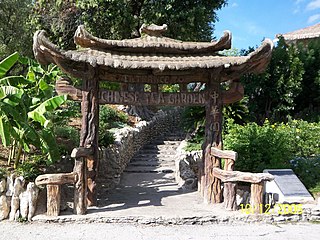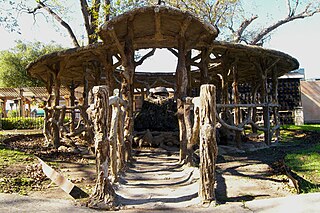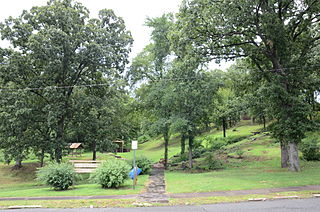
Green-Wood Cemetery is a 478-acre (193 ha) cemetery in the western portion of Brooklyn, New York City. The cemetery is located between South Slope/Greenwood Heights, Park Slope, Windsor Terrace, Borough Park, Kensington, and Sunset Park, and lies several blocks southwest of Prospect Park. Its boundaries include, among other streets, 20th Street to the northeast, Fifth Avenue to the northwest, 36th and 37th Streets to the southwest, Fort Hamilton Parkway to the south, and McDonald Avenue to the east.

The San Antonio Japanese Tea Garden, or Sunken Gardens in Brackenridge Park, San Antonio, Texas, opened in an abandoned limestone rock quarry in the early 20th century. It was known also as Chinese Tea Gardens, Chinese Tea Garden Gate, Chinese Sunken Garden Gate and is listed on the U.S. National Register of Historic Places. It is located on the northwestern edge of Brackenridge Park, near the San Antonio Zoo.

Memorial Park Cemetery was founded in 1924 by E. Clovis Hinds on initial 54 acres (.22 km2). It is located at 5668 Poplar Avenue in Memphis, Tennessee.

Faux bois refers to the artistic imitation of wood or wood grains in various media. The craft has roots in the Renaissance with trompe-l'œil. It was probably first crafted with concrete using an iron armature by garden craftsmen in France called "rocailleurs" using common iron materials: rods, barrel bands, and chicken wire.

The Majestic Theatre is San Antonio's oldest and largest atmospheric theatre. The theatre seats 2,264 people and was designed by architect John Eberson, for Karl Hoblitzelle's Interstate Theatres in 1929.

Dionicio Rodríguez (1891–1955) was a Mexican-born artist and architect whose work can be seen in Alabama, Arkansas, Illinois, Maryland, Michigan, New Mexico, Tennessee, and Texas, as well as Washington, D.C., and Mexico City.

La Villita Historic Arts Village is an art community in downtown San Antonio, Texas, United States. There are art galleries, stores selling souvenirs, gifts, custom jewelry, pottery, and imported Mexican folk art, as well as several restaurants in the district. La Villita connects to the San Antonio River Walk and its outdoor venue, the Arneson River Theatre. It is close to the Alamo, the Henry B. Gonzalez Convention Center, Rivercenter Mall, and HemisFair Park. It is within walking distance of most downtown hotels.

Cedar Hill Cemetery, previously known as Forest Lake Cemetery, and also formerly Nonesuch Plantation, is a cemetery located in Suitland, Maryland.

Couchwood is the summer estate of Harvey C. Couch, an industrialist and founder of Arkansas Power and Light in the early 20th century. The estate, located at 601 Couchwood Road, is southeast of Hot Springs, Arkansas, straddling the border of Garland and Hot Spring counties on the north shore of Lake Catherine.

Brackenridge Park is a 343-acre public park in San Antonio, Texas, USA, on the city's Broadway Corridor just north of downtown San Antonio.

The Woodlawn Garden of Memories is a cemetery in Houston, Texas which is included in the National Register of Historic Places. NRHP lists Dionicio Rodriguez as the cemetery's architect.

The Fence at Alamo Cement Company is a Faux Bois sculpture by artist Dionicio Rodriguez. The sculpture is a 125-foot-long concrete faux wood fence laid out in approximately a “C” shape and features an elaborate entrance way formed by two sculpted tree trunks. The sculpture was posted to the National Register of Historic Places on August 9, 2005.

The Fountain at Alamo Cement Company is a Faux Bois sculpture by artist Dionicio Rodriguez. The sculpture is a concrete pond covered by a concrete palapa style roof. The sculpture was posted to the National Register of Historic Places on August 9, 2005.

The California Quadrangle, California Building, and California Tower are historic structures located in Balboa Park in San Diego, California. They were built for the 1915–16 Panama-California Exposition and served as the grand entry to the Expo. The buildings and courtyard were designed by architect Bertram Goodhue. They were added to the National Register of Historic Places on May 17, 1974. They now house the Museum of Us.
The W. H. L. McCourtie Estate, originally called Aiden Lair and now known as McCourtie Park, is a recreational park located at 10426 South Jackson Road in Somerset Center, Michigan. It was designated a Michigan State Historic Site in 1991 and listed on the National Register of Historic Places in 1992. The site may contain the country's largest collection of el trabejo rustico, the Mexican folk art tradition where wet concrete is sculpted to look like wood.

Crestview Park is a small neighborhood park in North Little Rock, Arkansas. It is roughly bounded by Cherry Hill Drive, Crestview Drive, and the westbound onramp to Interstate 40 from Arkansas Highway 107. The park, set on a steeply sloping parcel, has no major amenities, and was established for passive recreational uses of the nearby population. The park is notable for the presence of two naturalistic sculptures by Dionicio Rodriguez that were installed c. 1933. One is a footbridge that appears to have been fashioned out of a fallen tree, and the other is rustic shelter, one of Rodriguez' more unusual works.
Little Switzerland is a historic property in Garland County, Arkansas. Located near the Couchwood estate of Harvey C. Couch in the Shorewood Hills area, the property was intended by Couch to be a place where he could go fishing with friends, but its development remained unfinished at his death. The property is notable for several pieces of artwork installed by the Mexican artist Dionicio Rodriguez. Rodriguez, known for his naturalistic-appearing artwork, installed a water wheel on a small lake, and a "wooden" bench. The major work he designed for the property was a barbecue that resembled a tree, with a 37-foot (11 m) base, and its smokestack concealed in the trunk. It was one of Rodriguez' largest works.

The Aviary at the Houston Zoo is a historic work of art created by Mexican-born architect and artist Dionicio Rodriguez located at the Houston Zoo in Houston, Texas and listed on the National Register of Historic Places. The Faux Bios sculptures were built in 1926 and dubbed the "flying sculpture." Although Hurricane Carla destroyed the aviary's wire superstructure in 1961, Rodriquez's sculptures remain and are composed of a tree, a fountain, logs, ledges and rock bordering a shallow pond which are now part of the Flamingo Habitat at the zoo.
Beatrice Valdez Ximénez was an American folk sculptor. With Consuelo González Amezcua and Alicia Dickerson Montemayor, she was one of a handful of Texas women of Mexican descent to win fame as a folk artist.


















